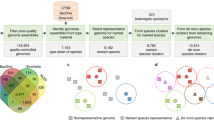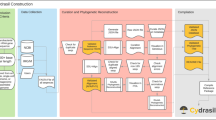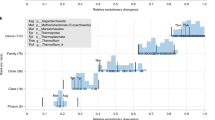Abstract
Metagenomic taxonomic classifiers analyze either DNA or amino acid (AA) sequences. Metabuli (https://metabuli.steineggerlab.com), however, jointly analyzes both DNA and AA to leverage AA conservation for sensitive homology detection and DNA mutations for specific differentiation of closely related taxa. In the Critical Assessment of Metagenome Interpretation 2 plant-associated dataset, Metabuli covered 99% and 98% of classifications of state-of-the-art DNA- and AA-based classifiers, respectively.
This is a preview of subscription content, access via your institution
Access options
Access Nature and 54 other Nature Portfolio journals
Get Nature+, our best-value online-access subscription
$29.99 / 30 days
cancel any time
Subscribe to this journal
Receive 12 print issues and online access
$259.00 per year
only $21.58 per issue
Buy this article
- Purchase on Springer Link
- Instant access to full article PDF
Prices may be subject to local taxes which are calculated during checkout


Similar content being viewed by others
Data availability
The raw data for Fig. 2 and Extended Data Figs. 1–4 are provided as Source data. Performance measures at different ranks of benchmarks of Fig. 2a,b and Extended Data Fig. 1 are available in Supplementary Tables 1–3. The assemblies used for read simulation and database creation in synthetic benchmarks are listed in Supplementary Table 4, and the simulated reads are available via Zenodo at https://doi.org/10.5281/zenodo.10250585 (ref. 28). More detailed results and utilized accessions of Fig. 2c,d are provided in Supplementary Tables 5 and 6. The databases used in Fig. 2c,d were built using viral genomes (release 212) and a human genome (GCF_009914755.1) downloaded from NCBI RefSeq, and accessions of genomes of analyzed SARS-CoV-2 variants were denoted in ‘Pathogen detection tests’ section in Methods. Performance measures at different ranks of Fig. 2e and Extended Data Fig. 2 are provided in Supplementary Tables 7–9. Precision and recall of Extended Data Fig. 4 are available in Supplementary Table 10. The accessions of real data analyzed in Fig. 2g,h and Extended Data Fig. 3 are denoted in ‘Benchmarks with real metagenomes’ section in Methods. CAMI2-provided datasets and taxonomy used in Fig. 2e,f and Extended Data Fig. 2 can be downloaded from https://data.cami-challenge.org/participate. Source data are provided with this paper.
Code availability
Metabuli is GPLv3-licensed free open-source software. The source code and ready-to-use binaries, as well as precomputed databases (Supplementary Table 11), can be downloaded at metabuli.steineggerlab.com. The scripts used for benchmarks and plots are available at https://github.com/jaebeom-kim/metabuli-analysis and https://github.com/jaebeom-kim/metabuli-plots.
References
Simon, H. Y., Siddle, K. J., Park, D. J. & Sabeti, P. C. Benchmarking metagenomics tools for taxonomic classification. Cell 178, 779–794 (2019).
Nooij, S., Schmitz, D., Vennema, H., Kroneman, A. & Koopmans, M. P. Overview of virus metagenomic classification methods and their biological applications. Front. Microbiol. 9, 749 (2018).
Mirdita, M., Steinegger, M., Breitwieser, F., Söding, J. & Levy Karin, E. Fast and sensitive taxonomic assignment to metagenomic contigs. Bioinformatics 37, 3029–3031 (2021).
Wood, D. E., Lu, J. & Langmead, B. Improved metagenomic analysis with Kraken 2. Genome Biol. 20, 1–13 (2019).
Breitwieser, F. P., Baker, D. N. & Salzberg, S. L. Krakenuniq: confident and fast metagenomics classification using unique k-mer counts. Genome Biol. 19, 198 (2018).
Menzel, P., Ng, K. L. & Krogh, A. Fast and sensitive taxonomic classification for metagenomics with Kaiju. Nat. Commun. 7, 11257 (2016).
Kim, D., Song, L., Breitwieser, F. P. & Salzberg, S. L. Centrifuge: rapid and sensitive classification of metagenomic sequences. Genome Res. 26, 1721–1729 (2016).
Dilthey, A. T., Jain, C., Koren, S. & Phillippy, A. M. Strain-level metagenomic assignment and compositional estimation for long reads with metamaps. Nat. Commun. 10, 3066 (2019).
Hyatt, D. et al. Prodigal: prokaryotic gene recognition and translation initiation site identification. BMC Bioinform. 11, 119 (2010).
Parks, D. H. et al. GTDB: an ongoing census of bacterial and archaeal diversity through a phylogenetically consistent, rank normalized and complete genome-based taxonomy. Nucleic Acids Res. 50, D785–D794 (2022).
Watson, M. & Warr, A. Errors in long-read assemblies can critically affect protein prediction. Nat. Biotechnol. 37, 124–126 (2019).
Meyer, F. et al. Critical assessment of metagenome interpretation: the second round of challenges. Nat. Methods 19, 429–440 (2022).
Nasko, D. J., Koren, S., Phillippy, A. M. & Treangen, T. J. Refseq database growth influences the accuracy of k-mer-based lowest common ancestor species identification. Genome Biol. 19, 1–10 (2018).
Lu, J. et al. Metagenome analysis using the Kraken software suite. Nat. Protoc. 17, 2815–2839 (2022).
Holtgrewe, M. Mason - A Read Simulator for Second Generation Sequencing Data. Technical Report (FU Berlin, 2010).
Ono, Y., Hamada, M. & Asai, K. PBSIM3: a simulator for all types of PacBio and ONT long reads. NAR Genom. Bioinform. 4, lqac092 (2022).
de la Cuesta-Zuluaga, J., Ley, R. E. & Youngblut, N. D. Struo: a pipeline for building custom databases for common metagenome profilers. Bioinformatics 36, 2314–2315 (2020).
Youngblut, N. & Shen, W. nick-youngblut/gtdb_to_taxdump: Zenodo release. Zenodo https://doi.org/10.5281/zenodo.3696964 (2020).
Frith, M. C. A new repeat-masking method enables specific detection of homologous sequences. Nucleic Acids Res. 39, e23 (2011).
Rahaman, M. M. et al. Genomic characterization of the dominating Beta, V2 variant carrying vaccinated (Oxford-AstraZeneca) and nonvaccinated COVID-19 patient samples in Bangladesh: a metagenomics and whole-genome approach. J. Med. Virol. 94, 1670–1688 (2022).
Lentini, A., Pereira, A., Winqvist, O. & Reinius, B. Monitoring of the SARS-CoV-2 Omicron BA.1/BA.2 lineage transition in the Swedish population reveals increased viral RNA levels in BA.2 cases. Med 3, 636–643 (2022).
Desai, N. et al. Temporal and spatial heterogeneity of host response to SARS-CoV-2 pulmonary infection. Nat. Commun. 11, 6319 (2020).
Gehrig, J. L. et al. Finding the right fit: evaluation of short-read and long-read sequencing approaches to maximize the utility of clinical microbiome data. Microb. Genom. 8, 000794 (2022).
Liu, L., Yang, Y., Deng, Y. & Zhang, T. Nanopore long-read-only metagenomics enables complete and high-quality genome reconstruction from mock and complex metagenomes. Microbiome 10, 209 (2022).
Barnes, S. J. et al. Metagenome-assembled genomes from photo-oxidized and nonoxidized oil-degrading marine microcosms. Microbiol. Resour. Announc. 12, 6 (2023).
Priest, T., Orellana, L. H., Huettel, B., Fuchs, B. M. & Amann, R. Microbial metagenome-assembled genomes of the Fram Strait from short and long read sequencing platforms. PeerJ 9, e11721 (2021).
Huang, R. et al. Long-read metagenomics of marine microbes reveals diversely expressed secondary metabolites. Microbiol. Spectr. 11, e0150123 (2023).
Kim, J. Simulated query reads used for benchmarks in Metabuli publication. Zenodo https://doi.org/10.5281/zenodo.10250585 (2023).
Acknowledgements
The authors thank E. Levy Karin for the valuable scientific feedback and the careful review and revision of the paper; J. Söding for the discussions on metamer encoding; M. Mirdita for the usability improvements of the software; H. Kim for the improvement of figures; S. Jaenicke for the voluntary examination of the software; and M. Kim for the feedback on the paper. M.S. acknowledges support by the National Research Foundation of Korea grants (2020M3-A9G7-103933, 2021-R1C1-C102065 and 2021-M3A9-I4021220), the Samsung DS research fund, and the Creative-Pioneering Researchers Program and AI-Bio Research Grant through Seoul National University.
Author information
Authors and Affiliations
Contributions
J.K. and M.S. designed the research, developed the software, performed analysis and wrote the paper.
Corresponding author
Ethics declarations
Competing interests
The authors declare no competing interests.
Peer review
Peer review information
Nature Methods thanks André Soares and the other, anonymous, reviewer(s) for their contribution to the peer review of this work. Primary Handling Editor: Lei Tang, in collaboration with the Nature Methods team. Peer reviewer reports are available.
Additional information
Publisher’s note Springer Nature remains neutral with regard to jurisdictional claims in published maps and institutional affiliations.
Extended data
Extended Data Fig. 1 Synthetic benchmark results.
Simulated short (Illumina) and long (PacBio HiFi, ONT, and PacBio Sequel II) reads were used for performance evaluation based on GTDB genomes and taxonomy. Hybrid = (x, y) is the result of applying the DNA-based tool x, followed by the AA-based tool y, where both are the best-performing. a–d Subspecies-level classification tests. Reads were simulated from subspecies present in databases, and precision and recall were measured at subspecies rank. a) Hybrid = (KrakenUniq, Kraken2x). b-d) Hybrid = (MetaMaps, Kraken2X). Raw data for performance measurements at subspecies, species, genus, and family ranks are available in Supplementary Table 1. e–h Species-level classification tests. Not the queried subspecies but their sibling subspecies were contained in databases to measure species-level classification. Hybrid = (KrakenUniq, Kraken2X). Raw data for performance measurements at species, genus, family, and order ranks are available in Supplementary Table 2. i–l Genus-level classification tests. Not the queried species but their sibling species were contained in databases, so how well each tool can detect homology within the same genus was measured. i) Hybrid = (Kraken2, MMseqs2). j-l) Hybrid = (Kraken2, Kraken2X). Raw data for performance measurements at genus, family, order, and class ranks are available in Supplementary Table 3.
Extended Data Fig. 2 Benchmarks using CAMI2’s strain-madness, marine, and plant-associated datasets.
GTDB genomes and the CAMI2-provided taxonomy were used for the database creation. CAMI2-provided short reads of strain-madness (a), marine (b), and plant-associated (c) datasets were classified by each tool, and the average values of the metrics that were measured at the species and genus rank for each sample were plotted. Raw data and metrics for each sample are available in Supplementary Tables 7–9.
Extended Data Fig. 3 Comparison of Metabuli to best performing AA- and DNA-based tools on real long-read metagenomic samples.
In contrast to Fig. 2g–h, Kraken2X instead of Kaiju is utilized due to its superior performance on long reads. The databases were built using GTDB genomes and a human genome (T2T-CHM13v2.0) based on GTDB taxonomy edited to include a human taxon. Real nanopore sequencing data from human gut (a) and marine (b) environments, as well as PacBio HiFi reads from human gut (c) and marine (d) environments, were classified by each tool. The area is proportional to the number of reads within each panel. The proportion of reads classified by each tool is denoted in parentheses.
Extended Data Fig. 4 Subspecies-level classification performance by clade size.
All 2,382 query subspecies used in Extended Data Fig. 1a were divided into groups according to the number of subspecies siblings they had in the reference database, that is, by their species clade size. The average F1 score for queries in each group decreases as the clade’s size increases, indicating that more sibling subspecies pose a harder classification challenge to all tools. Precision and recall are available in Supplementary Table 10.
Supplementary information
Supplementary Information
Supplementary Figs. 1–7.
Source data
Source Data Fig. 2
Statistical source data.
Source Data Extended Data Fig. 1
Statistical source data.
Source Data Extended Data Fig. 2
Statistical source data.
Source Data Extended Data Fig. 3
Statistical source data.
Source Data Extended Data Fig. 4
Statistical source data.
Rights and permissions
Springer Nature or its licensor (e.g. a society or other partner) holds exclusive rights to this article under a publishing agreement with the author(s) or other rightsholder(s); author self-archiving of the accepted manuscript version of this article is solely governed by the terms of such publishing agreement and applicable law.
About this article
Cite this article
Kim, J., Steinegger, M. Metabuli: sensitive and specific metagenomic classification via joint analysis of amino acid and DNA. Nat Methods (2024). https://doi.org/10.1038/s41592-024-02273-y
Received:
Accepted:
Published:
DOI: https://doi.org/10.1038/s41592-024-02273-y



